A Comprehensive Report on Contract and Negligence Law for Businesses
VerifiedAdded on 2019/12/28
|16
|4595
|195
Report
AI Summary
This report provides a comprehensive overview of contract and negligence law in a business context. It begins by defining the essential elements required for the formation of a valid contract, including offer, acceptance, consideration, and intention, and illustrates these concepts with relevant case law. The report then describes different types of contracts, such as unilateral, bilateral, and collateral contracts, and explains their implications. It further defines contractual terms, differentiating between express and implied terms, and discusses the role of exclusion clauses. The report includes a case study analyzing a scenario involving a defective product, applying the principles of contract and negligence law to determine liability. Finally, it contrasts liability in tort with contractual liability and explains the nature of liability in negligence, including vicarious liability of a business, applying the elements of the tort of negligence to the case scenario and the law of vicarious liability.
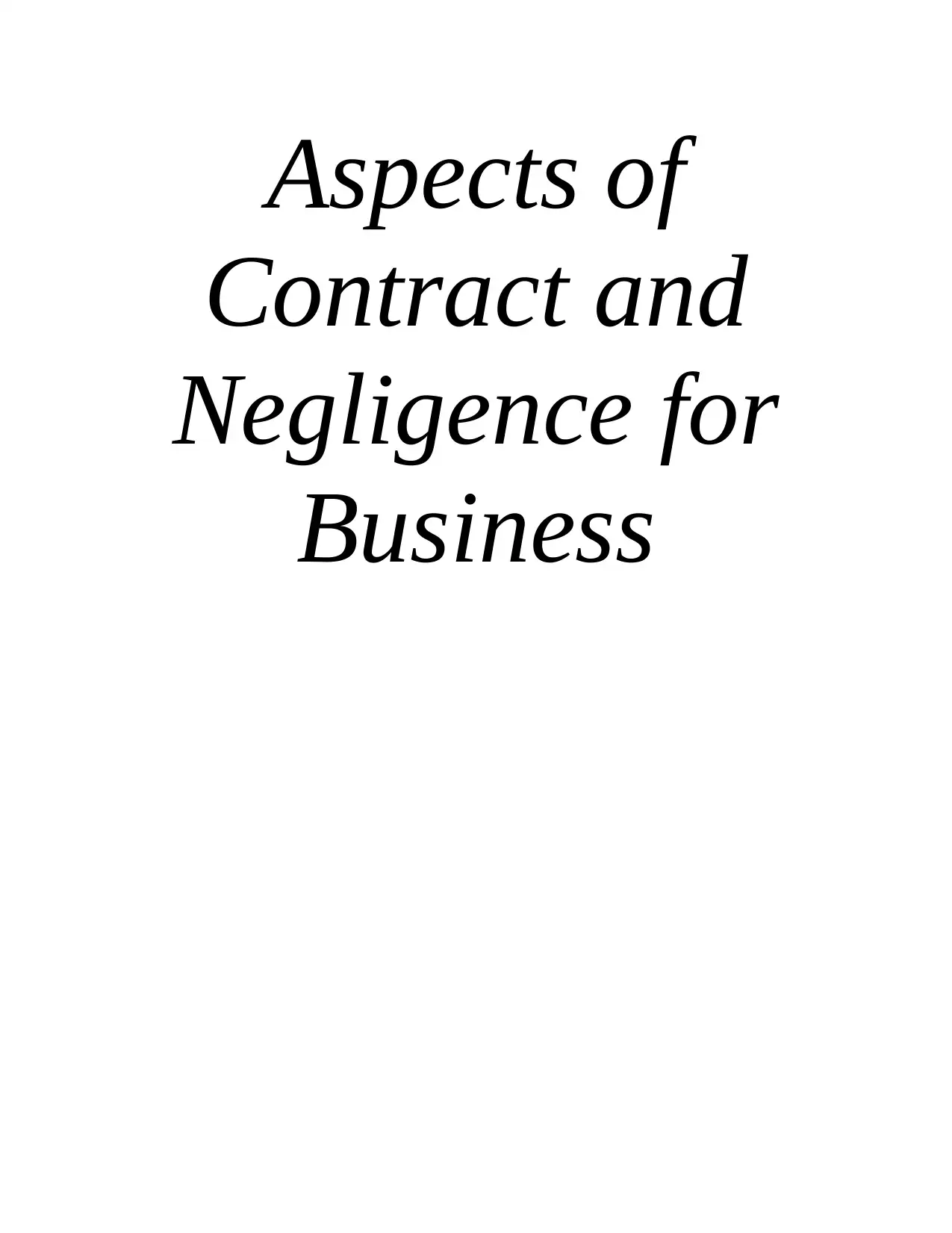
Aspects of
Contract and
Negligence for
Business
Contract and
Negligence for
Business
Paraphrase This Document
Need a fresh take? Get an instant paraphrase of this document with our AI Paraphraser
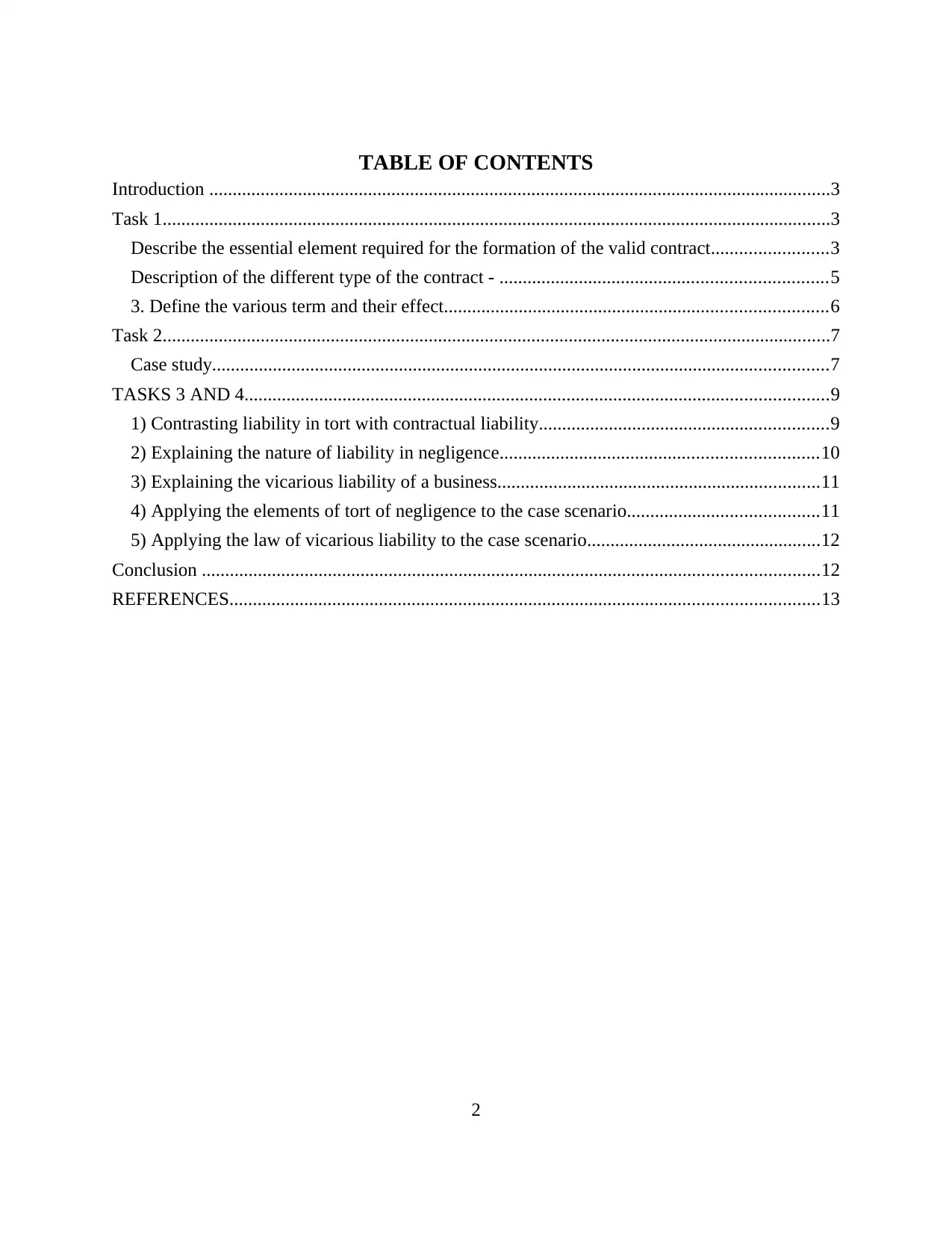
TABLE OF CONTENTS
Introduction .....................................................................................................................................3
Task 1...............................................................................................................................................3
Describe the essential element required for the formation of the valid contract.........................3
Description of the different type of the contract - ......................................................................5
3. Define the various term and their effect..................................................................................6
Task 2...............................................................................................................................................7
Case study....................................................................................................................................7
TASKS 3 AND 4.............................................................................................................................9
1) Contrasting liability in tort with contractual liability..............................................................9
2) Explaining the nature of liability in negligence....................................................................10
3) Explaining the vicarious liability of a business.....................................................................11
4) Applying the elements of tort of negligence to the case scenario.........................................11
5) Applying the law of vicarious liability to the case scenario..................................................12
Conclusion ....................................................................................................................................12
REFERENCES..............................................................................................................................13
2
Introduction .....................................................................................................................................3
Task 1...............................................................................................................................................3
Describe the essential element required for the formation of the valid contract.........................3
Description of the different type of the contract - ......................................................................5
3. Define the various term and their effect..................................................................................6
Task 2...............................................................................................................................................7
Case study....................................................................................................................................7
TASKS 3 AND 4.............................................................................................................................9
1) Contrasting liability in tort with contractual liability..............................................................9
2) Explaining the nature of liability in negligence....................................................................10
3) Explaining the vicarious liability of a business.....................................................................11
4) Applying the elements of tort of negligence to the case scenario.........................................11
5) Applying the law of vicarious liability to the case scenario..................................................12
Conclusion ....................................................................................................................................12
REFERENCES..............................................................................................................................13
2
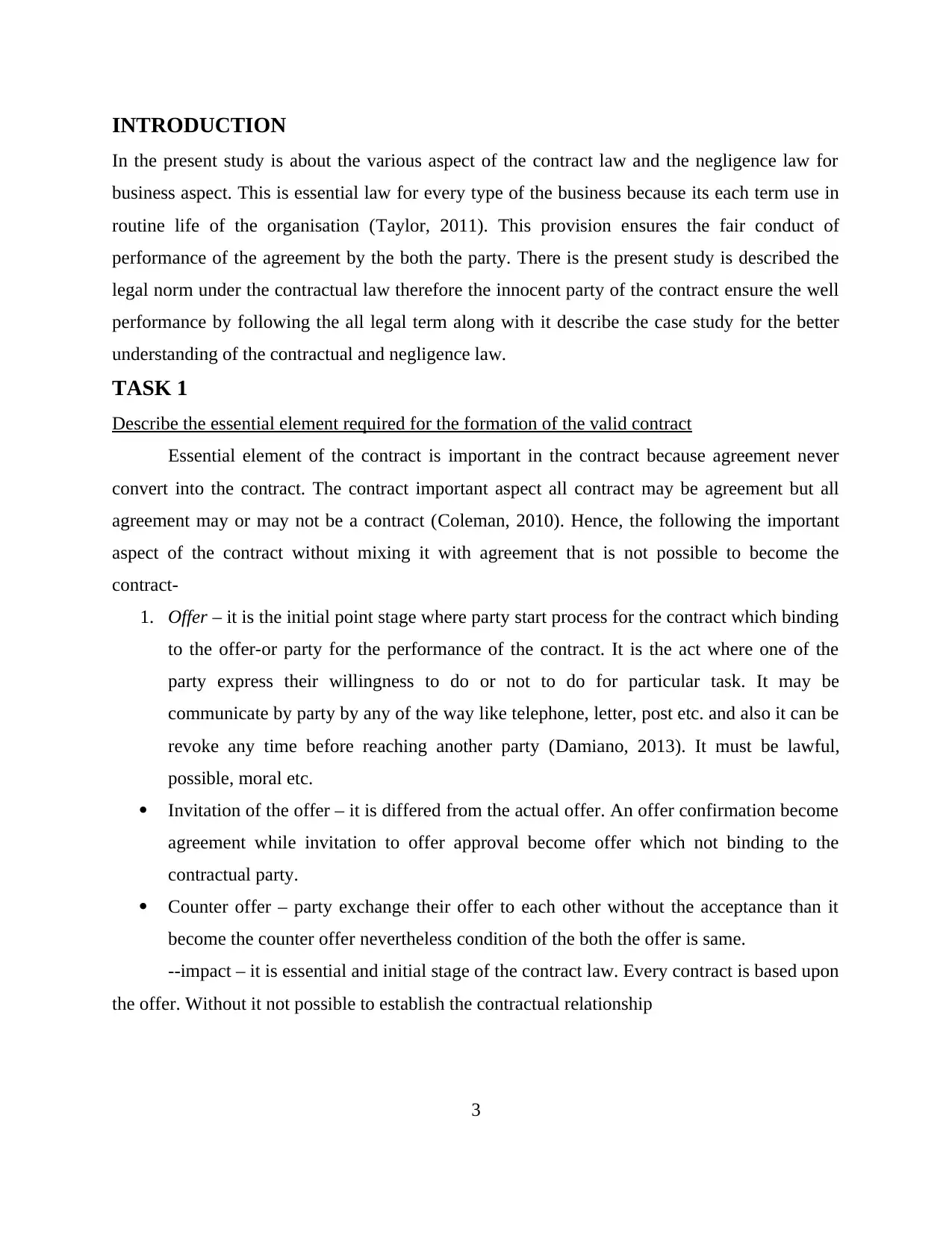
INTRODUCTION
In the present study is about the various aspect of the contract law and the negligence law for
business aspect. This is essential law for every type of the business because its each term use in
routine life of the organisation (Taylor, 2011). This provision ensures the fair conduct of
performance of the agreement by the both the party. There is the present study is described the
legal norm under the contractual law therefore the innocent party of the contract ensure the well
performance by following the all legal term along with it describe the case study for the better
understanding of the contractual and negligence law.
TASK 1
Describe the essential element required for the formation of the valid contract
Essential element of the contract is important in the contract because agreement never
convert into the contract. The contract important aspect all contract may be agreement but all
agreement may or may not be a contract (Coleman, 2010). Hence, the following the important
aspect of the contract without mixing it with agreement that is not possible to become the
contract-
1. Offer – it is the initial point stage where party start process for the contract which binding
to the offer-or party for the performance of the contract. It is the act where one of the
party express their willingness to do or not to do for particular task. It may be
communicate by party by any of the way like telephone, letter, post etc. and also it can be
revoke any time before reaching another party (Damiano, 2013). It must be lawful,
possible, moral etc.
Invitation of the offer – it is differed from the actual offer. An offer confirmation become
agreement while invitation to offer approval become offer which not binding to the
contractual party.
Counter offer – party exchange their offer to each other without the acceptance than it
become the counter offer nevertheless condition of the both the offer is same.
--impact – it is essential and initial stage of the contract law. Every contract is based upon
the offer. Without it not possible to establish the contractual relationship
3
In the present study is about the various aspect of the contract law and the negligence law for
business aspect. This is essential law for every type of the business because its each term use in
routine life of the organisation (Taylor, 2011). This provision ensures the fair conduct of
performance of the agreement by the both the party. There is the present study is described the
legal norm under the contractual law therefore the innocent party of the contract ensure the well
performance by following the all legal term along with it describe the case study for the better
understanding of the contractual and negligence law.
TASK 1
Describe the essential element required for the formation of the valid contract
Essential element of the contract is important in the contract because agreement never
convert into the contract. The contract important aspect all contract may be agreement but all
agreement may or may not be a contract (Coleman, 2010). Hence, the following the important
aspect of the contract without mixing it with agreement that is not possible to become the
contract-
1. Offer – it is the initial point stage where party start process for the contract which binding
to the offer-or party for the performance of the contract. It is the act where one of the
party express their willingness to do or not to do for particular task. It may be
communicate by party by any of the way like telephone, letter, post etc. and also it can be
revoke any time before reaching another party (Damiano, 2013). It must be lawful,
possible, moral etc.
Invitation of the offer – it is differed from the actual offer. An offer confirmation become
agreement while invitation to offer approval become offer which not binding to the
contractual party.
Counter offer – party exchange their offer to each other without the acceptance than it
become the counter offer nevertheless condition of the both the offer is same.
--impact – it is essential and initial stage of the contract law. Every contract is based upon
the offer. Without it not possible to establish the contractual relationship
3
⊘ This is a preview!⊘
Do you want full access?
Subscribe today to unlock all pages.

Trusted by 1+ million students worldwide
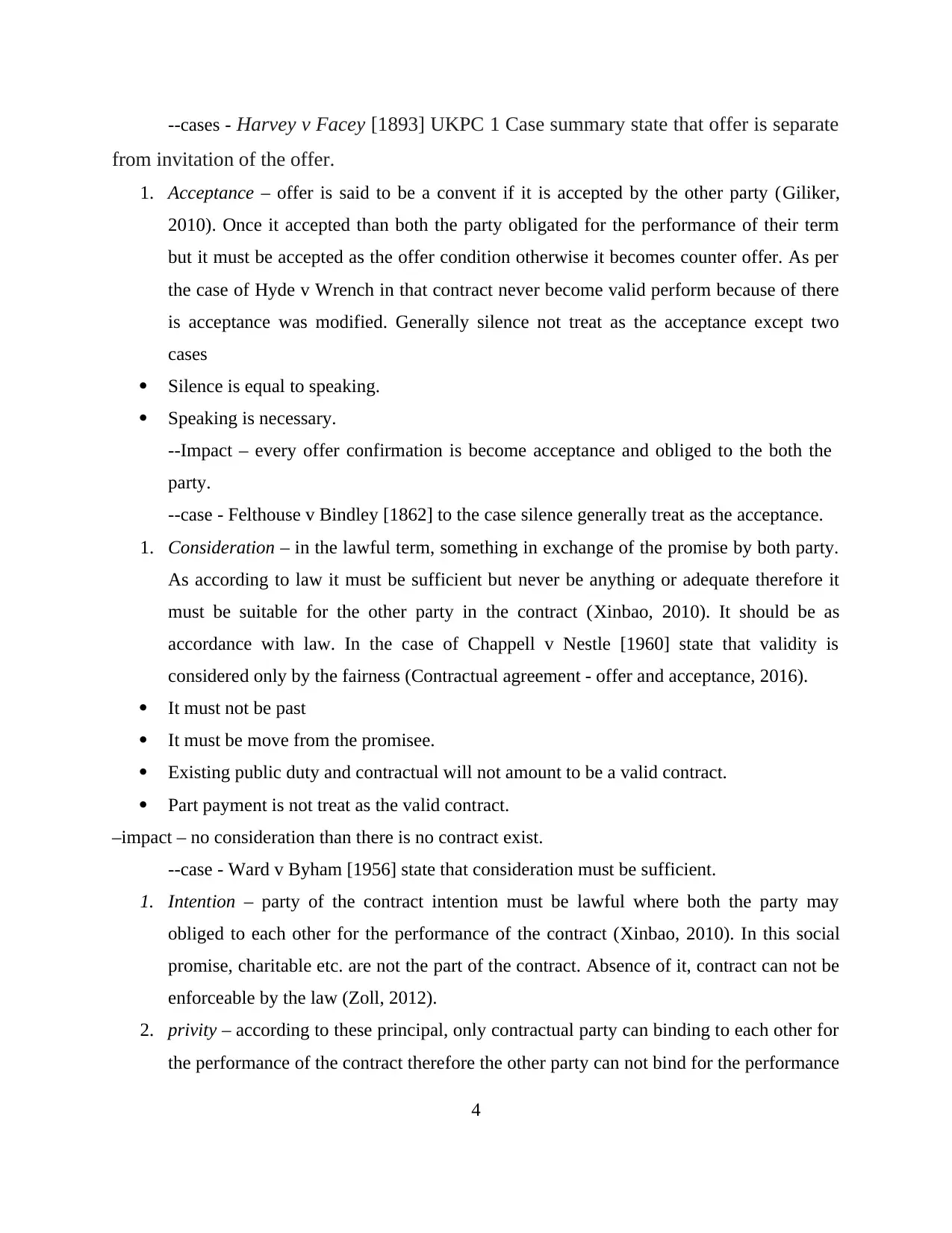
--cases - Harvey v Facey [1893] UKPC 1 Case summary state that offer is separate
from invitation of the offer.
1. Acceptance – offer is said to be a convent if it is accepted by the other party (Giliker,
2010). Once it accepted than both the party obligated for the performance of their term
but it must be accepted as the offer condition otherwise it becomes counter offer. As per
the case of Hyde v Wrench in that contract never become valid perform because of there
is acceptance was modified. Generally silence not treat as the acceptance except two
cases
Silence is equal to speaking.
Speaking is necessary.
--Impact – every offer confirmation is become acceptance and obliged to the both the
party.
--case - Felthouse v Bindley [1862] to the case silence generally treat as the acceptance.
1. Consideration – in the lawful term, something in exchange of the promise by both party.
As according to law it must be sufficient but never be anything or adequate therefore it
must be suitable for the other party in the contract (Xinbao, 2010). It should be as
accordance with law. In the case of Chappell v Nestle [1960] state that validity is
considered only by the fairness (Contractual agreement - offer and acceptance, 2016).
It must not be past
It must be move from the promisee.
Existing public duty and contractual will not amount to be a valid contract.
Part payment is not treat as the valid contract.
–impact – no consideration than there is no contract exist.
--case - Ward v Byham [1956] state that consideration must be sufficient.
1. Intention – party of the contract intention must be lawful where both the party may
obliged to each other for the performance of the contract (Xinbao, 2010). In this social
promise, charitable etc. are not the part of the contract. Absence of it, contract can not be
enforceable by the law (Zoll, 2012).
2. privity – according to these principal, only contractual party can binding to each other for
the performance of the contract therefore the other party can not bind for the performance
4
from invitation of the offer.
1. Acceptance – offer is said to be a convent if it is accepted by the other party (Giliker,
2010). Once it accepted than both the party obligated for the performance of their term
but it must be accepted as the offer condition otherwise it becomes counter offer. As per
the case of Hyde v Wrench in that contract never become valid perform because of there
is acceptance was modified. Generally silence not treat as the acceptance except two
cases
Silence is equal to speaking.
Speaking is necessary.
--Impact – every offer confirmation is become acceptance and obliged to the both the
party.
--case - Felthouse v Bindley [1862] to the case silence generally treat as the acceptance.
1. Consideration – in the lawful term, something in exchange of the promise by both party.
As according to law it must be sufficient but never be anything or adequate therefore it
must be suitable for the other party in the contract (Xinbao, 2010). It should be as
accordance with law. In the case of Chappell v Nestle [1960] state that validity is
considered only by the fairness (Contractual agreement - offer and acceptance, 2016).
It must not be past
It must be move from the promisee.
Existing public duty and contractual will not amount to be a valid contract.
Part payment is not treat as the valid contract.
–impact – no consideration than there is no contract exist.
--case - Ward v Byham [1956] state that consideration must be sufficient.
1. Intention – party of the contract intention must be lawful where both the party may
obliged to each other for the performance of the contract (Xinbao, 2010). In this social
promise, charitable etc. are not the part of the contract. Absence of it, contract can not be
enforceable by the law (Zoll, 2012).
2. privity – according to these principal, only contractual party can binding to each other for
the performance of the contract therefore the other party can not bind for the performance
4
Paraphrase This Document
Need a fresh take? Get an instant paraphrase of this document with our AI Paraphraser
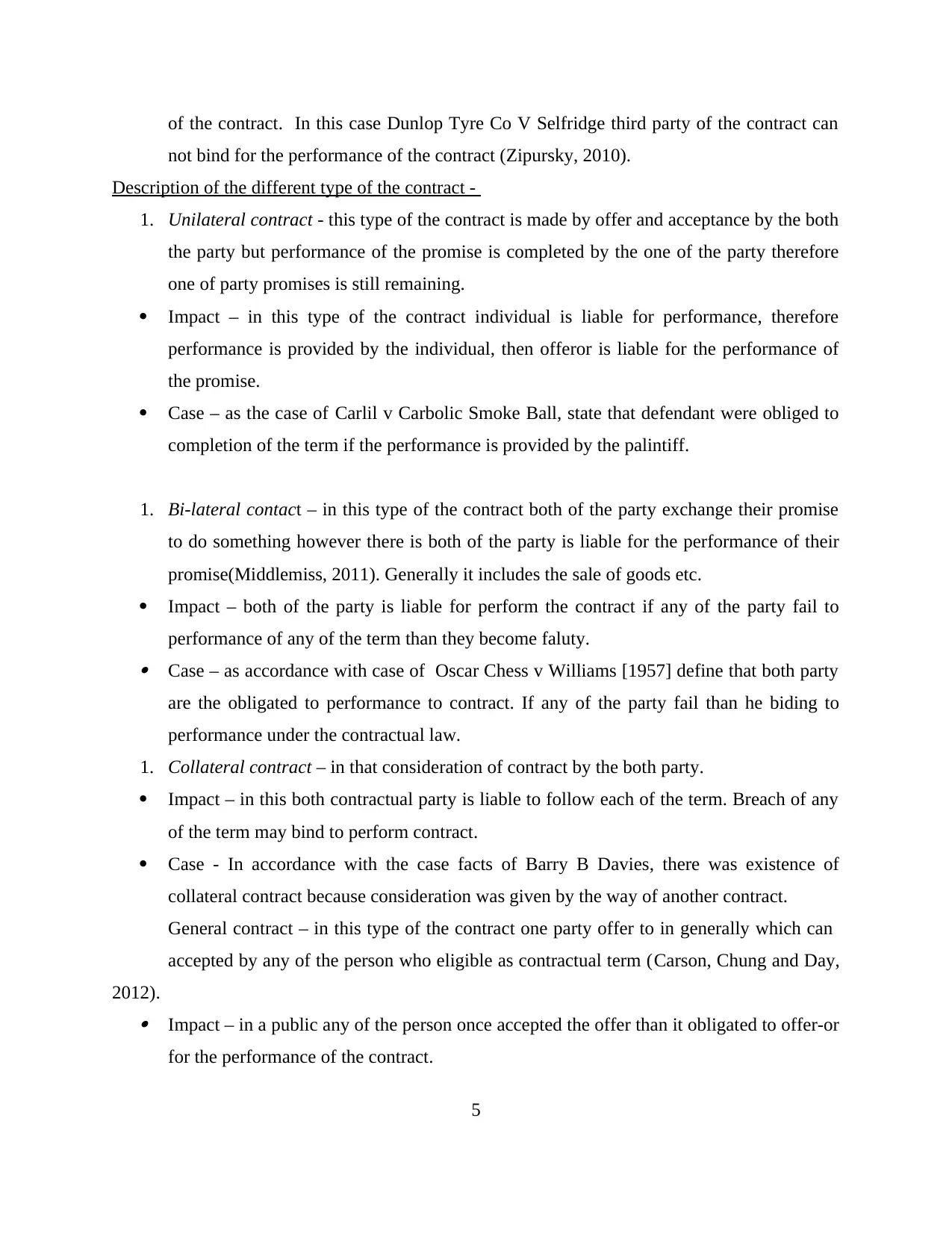
of the contract. In this case Dunlop Tyre Co V Selfridge third party of the contract can
not bind for the performance of the contract (Zipursky, 2010).
Description of the different type of the contract -
1. Unilateral contract - this type of the contract is made by offer and acceptance by the both
the party but performance of the promise is completed by the one of the party therefore
one of party promises is still remaining.
Impact – in this type of the contract individual is liable for performance, therefore
performance is provided by the individual, then offeror is liable for the performance of
the promise.
Case – as the case of Carlil v Carbolic Smoke Ball, state that defendant were obliged to
completion of the term if the performance is provided by the palintiff.
1. Bi-lateral contact – in this type of the contract both of the party exchange their promise
to do something however there is both of the party is liable for the performance of their
promise(Middlemiss, 2011). Generally it includes the sale of goods etc.
Impact – both of the party is liable for perform the contract if any of the party fail to
performance of any of the term than they become faluty. Case – as accordance with case of Oscar Chess v Williams [1957] define that both party
are the obligated to performance to contract. If any of the party fail than he biding to
performance under the contractual law.
1. Collateral contract – in that consideration of contract by the both party.
Impact – in this both contractual party is liable to follow each of the term. Breach of any
of the term may bind to perform contract.
Case - In accordance with the case facts of Barry B Davies, there was existence of
collateral contract because consideration was given by the way of another contract.
General contract – in this type of the contract one party offer to in generally which can
accepted by any of the person who eligible as contractual term (Carson, Chung and Day,
2012). Impact – in a public any of the person once accepted the offer than it obligated to offer-or
for the performance of the contract.
5
not bind for the performance of the contract (Zipursky, 2010).
Description of the different type of the contract -
1. Unilateral contract - this type of the contract is made by offer and acceptance by the both
the party but performance of the promise is completed by the one of the party therefore
one of party promises is still remaining.
Impact – in this type of the contract individual is liable for performance, therefore
performance is provided by the individual, then offeror is liable for the performance of
the promise.
Case – as the case of Carlil v Carbolic Smoke Ball, state that defendant were obliged to
completion of the term if the performance is provided by the palintiff.
1. Bi-lateral contact – in this type of the contract both of the party exchange their promise
to do something however there is both of the party is liable for the performance of their
promise(Middlemiss, 2011). Generally it includes the sale of goods etc.
Impact – both of the party is liable for perform the contract if any of the party fail to
performance of any of the term than they become faluty. Case – as accordance with case of Oscar Chess v Williams [1957] define that both party
are the obligated to performance to contract. If any of the party fail than he biding to
performance under the contractual law.
1. Collateral contract – in that consideration of contract by the both party.
Impact – in this both contractual party is liable to follow each of the term. Breach of any
of the term may bind to perform contract.
Case - In accordance with the case facts of Barry B Davies, there was existence of
collateral contract because consideration was given by the way of another contract.
General contract – in this type of the contract one party offer to in generally which can
accepted by any of the person who eligible as contractual term (Carson, Chung and Day,
2012). Impact – in a public any of the person once accepted the offer than it obligated to offer-or
for the performance of the contract.
5
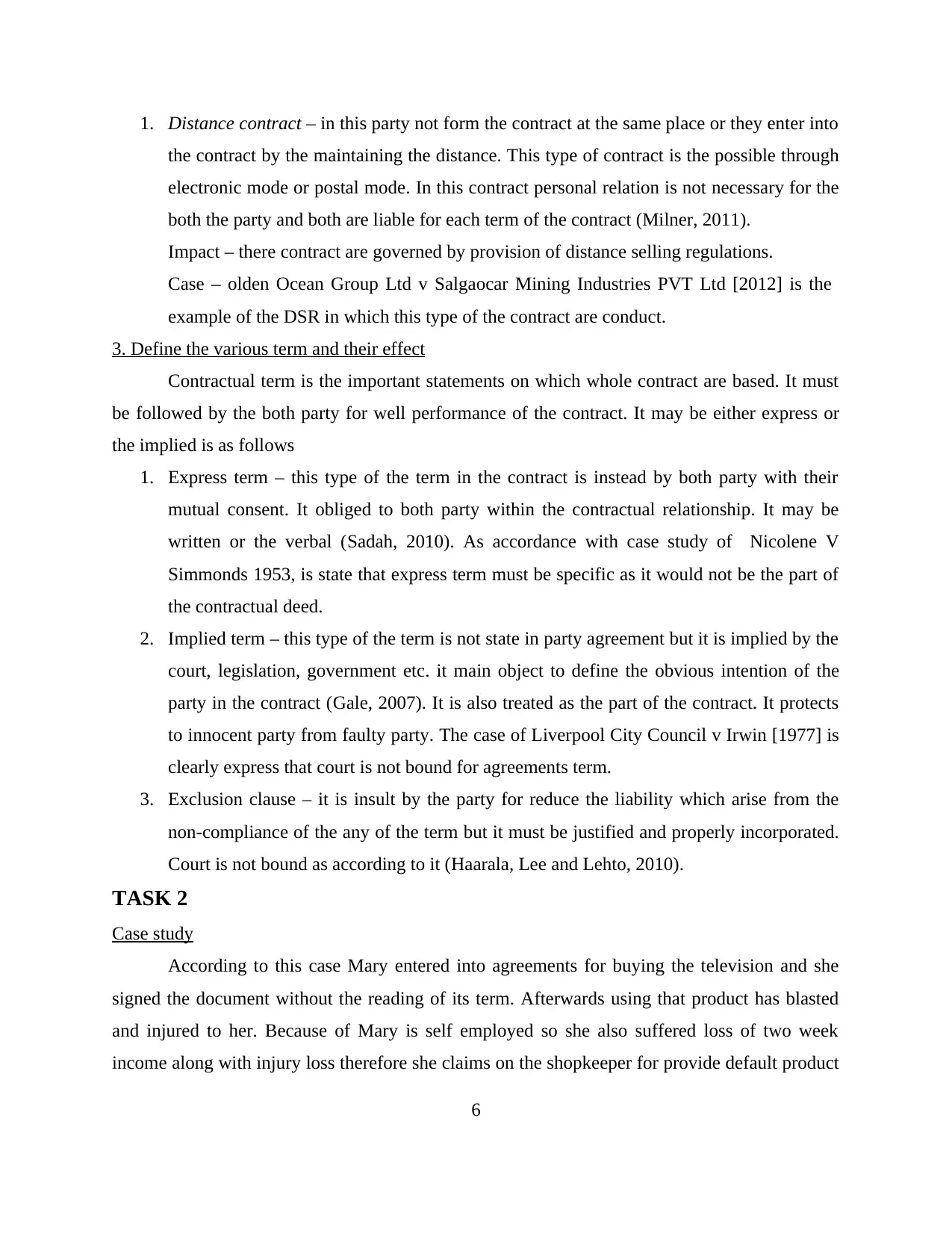
1. Distance contract – in this party not form the contract at the same place or they enter into
the contract by the maintaining the distance. This type of contract is the possible through
electronic mode or postal mode. In this contract personal relation is not necessary for the
both the party and both are liable for each term of the contract (Milner, 2011).
Impact – there contract are governed by provision of distance selling regulations.
Case – olden Ocean Group Ltd v Salgaocar Mining Industries PVT Ltd [2012] is the
example of the DSR in which this type of the contract are conduct.
3. Define the various term and their effect
Contractual term is the important statements on which whole contract are based. It must
be followed by the both party for well performance of the contract. It may be either express or
the implied is as follows
1. Express term – this type of the term in the contract is instead by both party with their
mutual consent. It obliged to both party within the contractual relationship. It may be
written or the verbal (Sadah, 2010). As accordance with case study of Nicolene V
Simmonds 1953, is state that express term must be specific as it would not be the part of
the contractual deed.
2. Implied term – this type of the term is not state in party agreement but it is implied by the
court, legislation, government etc. it main object to define the obvious intention of the
party in the contract (Gale, 2007). It is also treated as the part of the contract. It protects
to innocent party from faulty party. The case of Liverpool City Council v Irwin [1977] is
clearly express that court is not bound for agreements term.
3. Exclusion clause – it is insult by the party for reduce the liability which arise from the
non-compliance of the any of the term but it must be justified and properly incorporated.
Court is not bound as according to it (Haarala, Lee and Lehto, 2010).
TASK 2
Case study
According to this case Mary entered into agreements for buying the television and she
signed the document without the reading of its term. Afterwards using that product has blasted
and injured to her. Because of Mary is self employed so she also suffered loss of two week
income along with injury loss therefore she claims on the shopkeeper for provide default product
6
the contract by the maintaining the distance. This type of contract is the possible through
electronic mode or postal mode. In this contract personal relation is not necessary for the
both the party and both are liable for each term of the contract (Milner, 2011).
Impact – there contract are governed by provision of distance selling regulations.
Case – olden Ocean Group Ltd v Salgaocar Mining Industries PVT Ltd [2012] is the
example of the DSR in which this type of the contract are conduct.
3. Define the various term and their effect
Contractual term is the important statements on which whole contract are based. It must
be followed by the both party for well performance of the contract. It may be either express or
the implied is as follows
1. Express term – this type of the term in the contract is instead by both party with their
mutual consent. It obliged to both party within the contractual relationship. It may be
written or the verbal (Sadah, 2010). As accordance with case study of Nicolene V
Simmonds 1953, is state that express term must be specific as it would not be the part of
the contractual deed.
2. Implied term – this type of the term is not state in party agreement but it is implied by the
court, legislation, government etc. it main object to define the obvious intention of the
party in the contract (Gale, 2007). It is also treated as the part of the contract. It protects
to innocent party from faulty party. The case of Liverpool City Council v Irwin [1977] is
clearly express that court is not bound for agreements term.
3. Exclusion clause – it is insult by the party for reduce the liability which arise from the
non-compliance of the any of the term but it must be justified and properly incorporated.
Court is not bound as according to it (Haarala, Lee and Lehto, 2010).
TASK 2
Case study
According to this case Mary entered into agreements for buying the television and she
signed the document without the reading of its term. Afterwards using that product has blasted
and injured to her. Because of Mary is self employed so she also suffered loss of two week
income along with injury loss therefore she claims on the shopkeeper for provide default product
6
⊘ This is a preview!⊘
Do you want full access?
Subscribe today to unlock all pages.

Trusted by 1+ million students worldwide
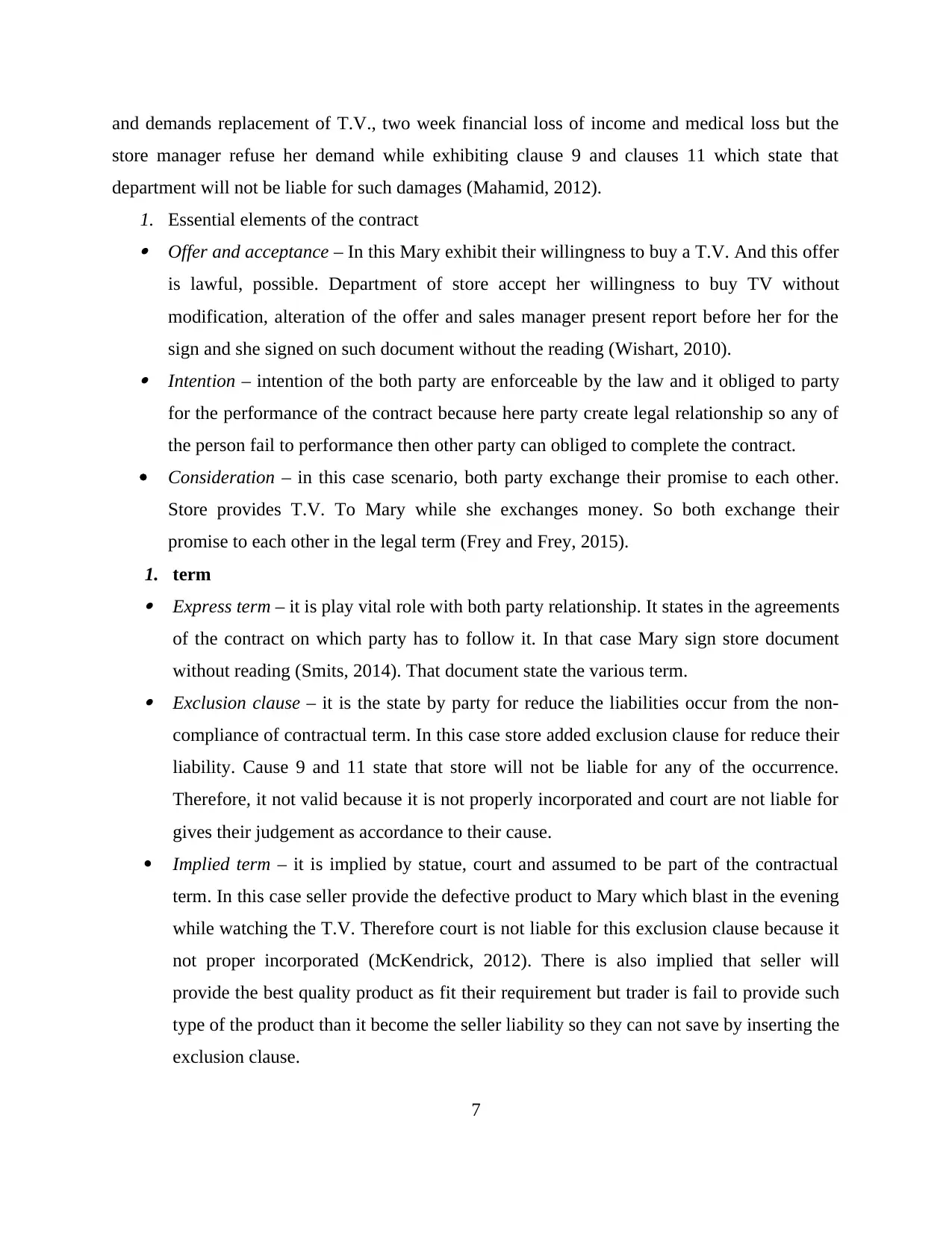
and demands replacement of T.V., two week financial loss of income and medical loss but the
store manager refuse her demand while exhibiting clause 9 and clauses 11 which state that
department will not be liable for such damages (Mahamid, 2012).
1. Essential elements of the contract Offer and acceptance – In this Mary exhibit their willingness to buy a T.V. And this offer
is lawful, possible. Department of store accept her willingness to buy TV without
modification, alteration of the offer and sales manager present report before her for the
sign and she signed on such document without the reading (Wishart, 2010). Intention – intention of the both party are enforceable by the law and it obliged to party
for the performance of the contract because here party create legal relationship so any of
the person fail to performance then other party can obliged to complete the contract.
Consideration – in this case scenario, both party exchange their promise to each other.
Store provides T.V. To Mary while she exchanges money. So both exchange their
promise to each other in the legal term (Frey and Frey, 2015).
1. term Express term – it is play vital role with both party relationship. It states in the agreements
of the contract on which party has to follow it. In that case Mary sign store document
without reading (Smits, 2014). That document state the various term. Exclusion clause – it is the state by party for reduce the liabilities occur from the non-
compliance of contractual term. In this case store added exclusion clause for reduce their
liability. Cause 9 and 11 state that store will not be liable for any of the occurrence.
Therefore, it not valid because it is not properly incorporated and court are not liable for
gives their judgement as accordance to their cause.
Implied term – it is implied by statue, court and assumed to be part of the contractual
term. In this case seller provide the defective product to Mary which blast in the evening
while watching the T.V. Therefore court is not liable for this exclusion clause because it
not proper incorporated (McKendrick, 2012). There is also implied that seller will
provide the best quality product as fit their requirement but trader is fail to provide such
type of the product than it become the seller liability so they can not save by inserting the
exclusion clause.
7
store manager refuse her demand while exhibiting clause 9 and clauses 11 which state that
department will not be liable for such damages (Mahamid, 2012).
1. Essential elements of the contract Offer and acceptance – In this Mary exhibit their willingness to buy a T.V. And this offer
is lawful, possible. Department of store accept her willingness to buy TV without
modification, alteration of the offer and sales manager present report before her for the
sign and she signed on such document without the reading (Wishart, 2010). Intention – intention of the both party are enforceable by the law and it obliged to party
for the performance of the contract because here party create legal relationship so any of
the person fail to performance then other party can obliged to complete the contract.
Consideration – in this case scenario, both party exchange their promise to each other.
Store provides T.V. To Mary while she exchanges money. So both exchange their
promise to each other in the legal term (Frey and Frey, 2015).
1. term Express term – it is play vital role with both party relationship. It states in the agreements
of the contract on which party has to follow it. In that case Mary sign store document
without reading (Smits, 2014). That document state the various term. Exclusion clause – it is the state by party for reduce the liabilities occur from the non-
compliance of contractual term. In this case store added exclusion clause for reduce their
liability. Cause 9 and 11 state that store will not be liable for any of the occurrence.
Therefore, it not valid because it is not properly incorporated and court are not liable for
gives their judgement as accordance to their cause.
Implied term – it is implied by statue, court and assumed to be part of the contractual
term. In this case seller provide the defective product to Mary which blast in the evening
while watching the T.V. Therefore court is not liable for this exclusion clause because it
not proper incorporated (McKendrick, 2012). There is also implied that seller will
provide the best quality product as fit their requirement but trader is fail to provide such
type of the product than it become the seller liability so they can not save by inserting the
exclusion clause.
7
Paraphrase This Document
Need a fresh take? Get an instant paraphrase of this document with our AI Paraphraser
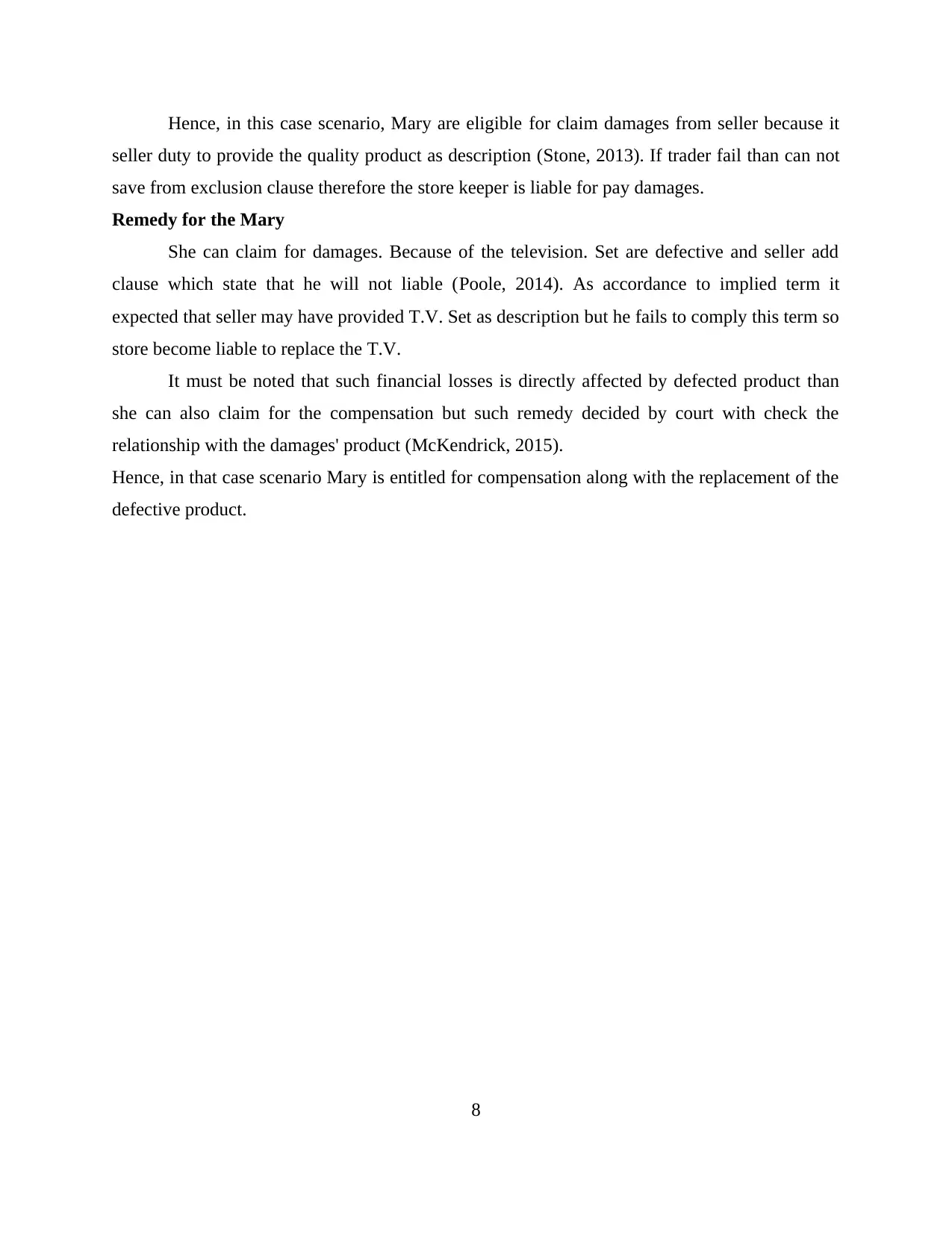
Hence, in this case scenario, Mary are eligible for claim damages from seller because it
seller duty to provide the quality product as description (Stone, 2013). If trader fail than can not
save from exclusion clause therefore the store keeper is liable for pay damages.
Remedy for the Mary
She can claim for damages. Because of the television. Set are defective and seller add
clause which state that he will not liable (Poole, 2014). As accordance to implied term it
expected that seller may have provided T.V. Set as description but he fails to comply this term so
store become liable to replace the T.V.
It must be noted that such financial losses is directly affected by defected product than
she can also claim for the compensation but such remedy decided by court with check the
relationship with the damages' product (McKendrick, 2015).
Hence, in that case scenario Mary is entitled for compensation along with the replacement of the
defective product.
8
seller duty to provide the quality product as description (Stone, 2013). If trader fail than can not
save from exclusion clause therefore the store keeper is liable for pay damages.
Remedy for the Mary
She can claim for damages. Because of the television. Set are defective and seller add
clause which state that he will not liable (Poole, 2014). As accordance to implied term it
expected that seller may have provided T.V. Set as description but he fails to comply this term so
store become liable to replace the T.V.
It must be noted that such financial losses is directly affected by defected product than
she can also claim for the compensation but such remedy decided by court with check the
relationship with the damages' product (McKendrick, 2015).
Hence, in that case scenario Mary is entitled for compensation along with the replacement of the
defective product.
8
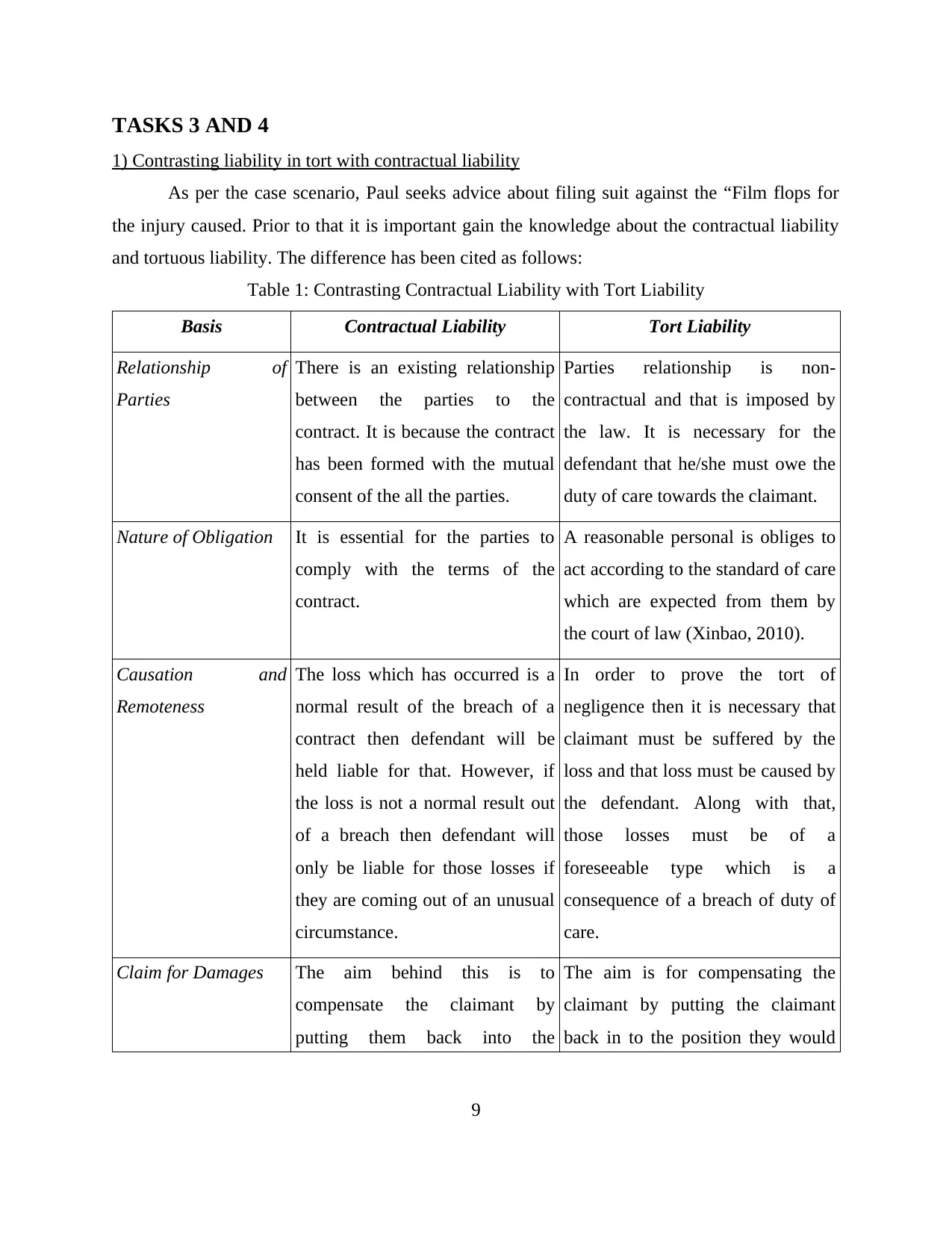
TASKS 3 AND 4
1) Contrasting liability in tort with contractual liability
As per the case scenario, Paul seeks advice about filing suit against the “Film flops for
the injury caused. Prior to that it is important gain the knowledge about the contractual liability
and tortuous liability. The difference has been cited as follows:
Table 1: Contrasting Contractual Liability with Tort Liability
Basis Contractual Liability Tort Liability
Relationship of
Parties
There is an existing relationship
between the parties to the
contract. It is because the contract
has been formed with the mutual
consent of the all the parties.
Parties relationship is non-
contractual and that is imposed by
the law. It is necessary for the
defendant that he/she must owe the
duty of care towards the claimant.
Nature of Obligation It is essential for the parties to
comply with the terms of the
contract.
A reasonable personal is obliges to
act according to the standard of care
which are expected from them by
the court of law (Xinbao, 2010).
Causation and
Remoteness
The loss which has occurred is a
normal result of the breach of a
contract then defendant will be
held liable for that. However, if
the loss is not a normal result out
of a breach then defendant will
only be liable for those losses if
they are coming out of an unusual
circumstance.
In order to prove the tort of
negligence then it is necessary that
claimant must be suffered by the
loss and that loss must be caused by
the defendant. Along with that,
those losses must be of a
foreseeable type which is a
consequence of a breach of duty of
care.
Claim for Damages The aim behind this is to
compensate the claimant by
putting them back into the
The aim is for compensating the
claimant by putting the claimant
back in to the position they would
9
1) Contrasting liability in tort with contractual liability
As per the case scenario, Paul seeks advice about filing suit against the “Film flops for
the injury caused. Prior to that it is important gain the knowledge about the contractual liability
and tortuous liability. The difference has been cited as follows:
Table 1: Contrasting Contractual Liability with Tort Liability
Basis Contractual Liability Tort Liability
Relationship of
Parties
There is an existing relationship
between the parties to the
contract. It is because the contract
has been formed with the mutual
consent of the all the parties.
Parties relationship is non-
contractual and that is imposed by
the law. It is necessary for the
defendant that he/she must owe the
duty of care towards the claimant.
Nature of Obligation It is essential for the parties to
comply with the terms of the
contract.
A reasonable personal is obliges to
act according to the standard of care
which are expected from them by
the court of law (Xinbao, 2010).
Causation and
Remoteness
The loss which has occurred is a
normal result of the breach of a
contract then defendant will be
held liable for that. However, if
the loss is not a normal result out
of a breach then defendant will
only be liable for those losses if
they are coming out of an unusual
circumstance.
In order to prove the tort of
negligence then it is necessary that
claimant must be suffered by the
loss and that loss must be caused by
the defendant. Along with that,
those losses must be of a
foreseeable type which is a
consequence of a breach of duty of
care.
Claim for Damages The aim behind this is to
compensate the claimant by
putting them back into the
The aim is for compensating the
claimant by putting the claimant
back in to the position they would
9
⊘ This is a preview!⊘
Do you want full access?
Subscribe today to unlock all pages.

Trusted by 1+ million students worldwide
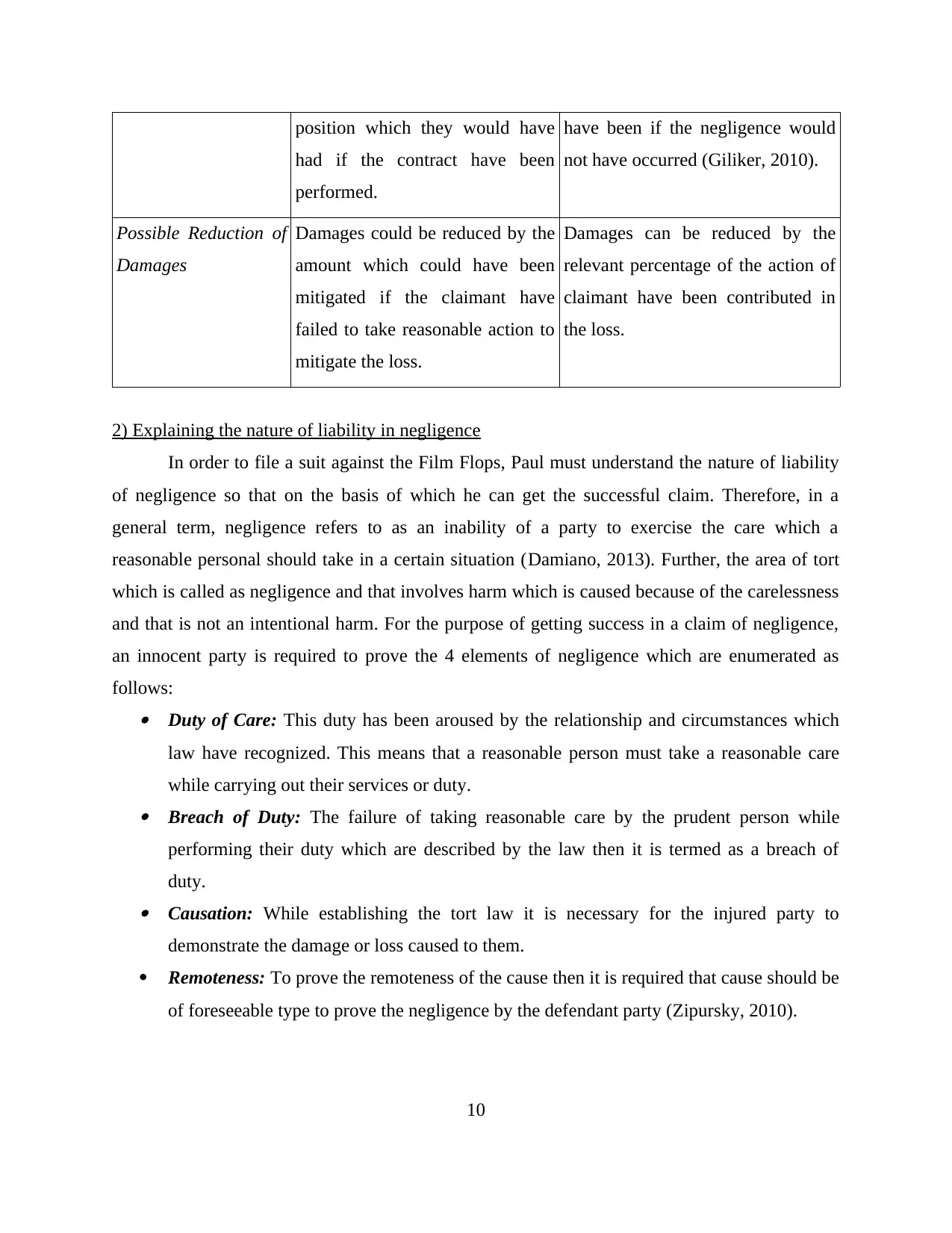
position which they would have
had if the contract have been
performed.
have been if the negligence would
not have occurred (Giliker, 2010).
Possible Reduction of
Damages
Damages could be reduced by the
amount which could have been
mitigated if the claimant have
failed to take reasonable action to
mitigate the loss.
Damages can be reduced by the
relevant percentage of the action of
claimant have been contributed in
the loss.
2) Explaining the nature of liability in negligence
In order to file a suit against the Film Flops, Paul must understand the nature of liability
of negligence so that on the basis of which he can get the successful claim. Therefore, in a
general term, negligence refers to as an inability of a party to exercise the care which a
reasonable personal should take in a certain situation (Damiano, 2013). Further, the area of tort
which is called as negligence and that involves harm which is caused because of the carelessness
and that is not an intentional harm. For the purpose of getting success in a claim of negligence,
an innocent party is required to prove the 4 elements of negligence which are enumerated as
follows: Duty of Care: This duty has been aroused by the relationship and circumstances which
law have recognized. This means that a reasonable person must take a reasonable care
while carrying out their services or duty. Breach of Duty: The failure of taking reasonable care by the prudent person while
performing their duty which are described by the law then it is termed as a breach of
duty. Causation: While establishing the tort law it is necessary for the injured party to
demonstrate the damage or loss caused to them.
Remoteness: To prove the remoteness of the cause then it is required that cause should be
of foreseeable type to prove the negligence by the defendant party (Zipursky, 2010).
10
had if the contract have been
performed.
have been if the negligence would
not have occurred (Giliker, 2010).
Possible Reduction of
Damages
Damages could be reduced by the
amount which could have been
mitigated if the claimant have
failed to take reasonable action to
mitigate the loss.
Damages can be reduced by the
relevant percentage of the action of
claimant have been contributed in
the loss.
2) Explaining the nature of liability in negligence
In order to file a suit against the Film Flops, Paul must understand the nature of liability
of negligence so that on the basis of which he can get the successful claim. Therefore, in a
general term, negligence refers to as an inability of a party to exercise the care which a
reasonable personal should take in a certain situation (Damiano, 2013). Further, the area of tort
which is called as negligence and that involves harm which is caused because of the carelessness
and that is not an intentional harm. For the purpose of getting success in a claim of negligence,
an innocent party is required to prove the 4 elements of negligence which are enumerated as
follows: Duty of Care: This duty has been aroused by the relationship and circumstances which
law have recognized. This means that a reasonable person must take a reasonable care
while carrying out their services or duty. Breach of Duty: The failure of taking reasonable care by the prudent person while
performing their duty which are described by the law then it is termed as a breach of
duty. Causation: While establishing the tort law it is necessary for the injured party to
demonstrate the damage or loss caused to them.
Remoteness: To prove the remoteness of the cause then it is required that cause should be
of foreseeable type to prove the negligence by the defendant party (Zipursky, 2010).
10
Paraphrase This Document
Need a fresh take? Get an instant paraphrase of this document with our AI Paraphraser
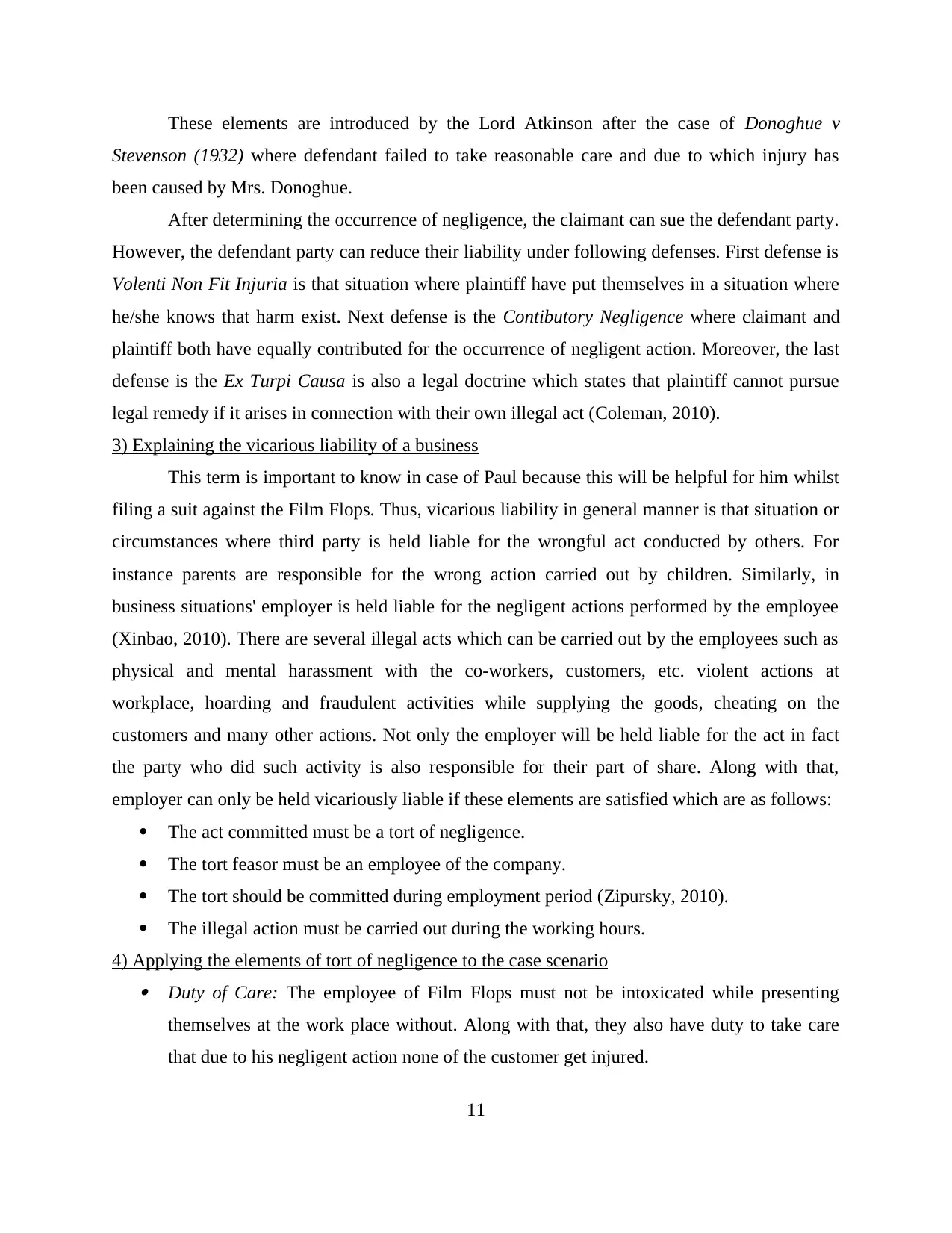
These elements are introduced by the Lord Atkinson after the case of Donoghue v
Stevenson (1932) where defendant failed to take reasonable care and due to which injury has
been caused by Mrs. Donoghue.
After determining the occurrence of negligence, the claimant can sue the defendant party.
However, the defendant party can reduce their liability under following defenses. First defense is
Volenti Non Fit Injuria is that situation where plaintiff have put themselves in a situation where
he/she knows that harm exist. Next defense is the Contibutory Negligence where claimant and
plaintiff both have equally contributed for the occurrence of negligent action. Moreover, the last
defense is the Ex Turpi Causa is also a legal doctrine which states that plaintiff cannot pursue
legal remedy if it arises in connection with their own illegal act (Coleman, 2010).
3) Explaining the vicarious liability of a business
This term is important to know in case of Paul because this will be helpful for him whilst
filing a suit against the Film Flops. Thus, vicarious liability in general manner is that situation or
circumstances where third party is held liable for the wrongful act conducted by others. For
instance parents are responsible for the wrong action carried out by children. Similarly, in
business situations' employer is held liable for the negligent actions performed by the employee
(Xinbao, 2010). There are several illegal acts which can be carried out by the employees such as
physical and mental harassment with the co-workers, customers, etc. violent actions at
workplace, hoarding and fraudulent activities while supplying the goods, cheating on the
customers and many other actions. Not only the employer will be held liable for the act in fact
the party who did such activity is also responsible for their part of share. Along with that,
employer can only be held vicariously liable if these elements are satisfied which are as follows:
The act committed must be a tort of negligence.
The tort feasor must be an employee of the company.
The tort should be committed during employment period (Zipursky, 2010).
The illegal action must be carried out during the working hours.
4) Applying the elements of tort of negligence to the case scenario Duty of Care: The employee of Film Flops must not be intoxicated while presenting
themselves at the work place without. Along with that, they also have duty to take care
that due to his negligent action none of the customer get injured.
11
Stevenson (1932) where defendant failed to take reasonable care and due to which injury has
been caused by Mrs. Donoghue.
After determining the occurrence of negligence, the claimant can sue the defendant party.
However, the defendant party can reduce their liability under following defenses. First defense is
Volenti Non Fit Injuria is that situation where plaintiff have put themselves in a situation where
he/she knows that harm exist. Next defense is the Contibutory Negligence where claimant and
plaintiff both have equally contributed for the occurrence of negligent action. Moreover, the last
defense is the Ex Turpi Causa is also a legal doctrine which states that plaintiff cannot pursue
legal remedy if it arises in connection with their own illegal act (Coleman, 2010).
3) Explaining the vicarious liability of a business
This term is important to know in case of Paul because this will be helpful for him whilst
filing a suit against the Film Flops. Thus, vicarious liability in general manner is that situation or
circumstances where third party is held liable for the wrongful act conducted by others. For
instance parents are responsible for the wrong action carried out by children. Similarly, in
business situations' employer is held liable for the negligent actions performed by the employee
(Xinbao, 2010). There are several illegal acts which can be carried out by the employees such as
physical and mental harassment with the co-workers, customers, etc. violent actions at
workplace, hoarding and fraudulent activities while supplying the goods, cheating on the
customers and many other actions. Not only the employer will be held liable for the act in fact
the party who did such activity is also responsible for their part of share. Along with that,
employer can only be held vicariously liable if these elements are satisfied which are as follows:
The act committed must be a tort of negligence.
The tort feasor must be an employee of the company.
The tort should be committed during employment period (Zipursky, 2010).
The illegal action must be carried out during the working hours.
4) Applying the elements of tort of negligence to the case scenario Duty of Care: The employee of Film Flops must not be intoxicated while presenting
themselves at the work place without. Along with that, they also have duty to take care
that due to his negligent action none of the customer get injured.
11
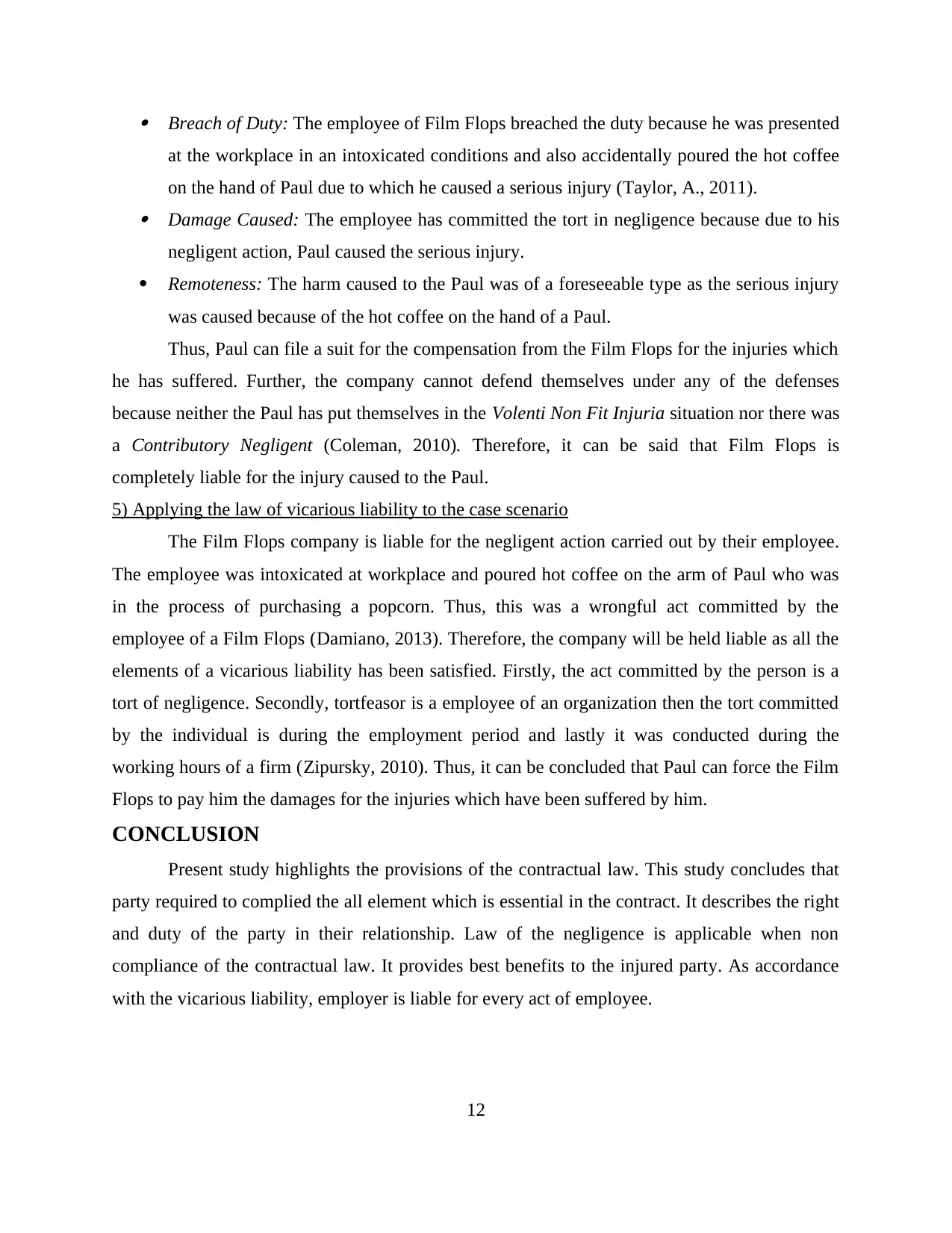
Breach of Duty: The employee of Film Flops breached the duty because he was presented
at the workplace in an intoxicated conditions and also accidentally poured the hot coffee
on the hand of Paul due to which he caused a serious injury (Taylor, A., 2011). Damage Caused: The employee has committed the tort in negligence because due to his
negligent action, Paul caused the serious injury.
Remoteness: The harm caused to the Paul was of a foreseeable type as the serious injury
was caused because of the hot coffee on the hand of a Paul.
Thus, Paul can file a suit for the compensation from the Film Flops for the injuries which
he has suffered. Further, the company cannot defend themselves under any of the defenses
because neither the Paul has put themselves in the Volenti Non Fit Injuria situation nor there was
a Contributory Negligent (Coleman, 2010). Therefore, it can be said that Film Flops is
completely liable for the injury caused to the Paul.
5) Applying the law of vicarious liability to the case scenario
The Film Flops company is liable for the negligent action carried out by their employee.
The employee was intoxicated at workplace and poured hot coffee on the arm of Paul who was
in the process of purchasing a popcorn. Thus, this was a wrongful act committed by the
employee of a Film Flops (Damiano, 2013). Therefore, the company will be held liable as all the
elements of a vicarious liability has been satisfied. Firstly, the act committed by the person is a
tort of negligence. Secondly, tortfeasor is a employee of an organization then the tort committed
by the individual is during the employment period and lastly it was conducted during the
working hours of a firm (Zipursky, 2010). Thus, it can be concluded that Paul can force the Film
Flops to pay him the damages for the injuries which have been suffered by him.
CONCLUSION
Present study highlights the provisions of the contractual law. This study concludes that
party required to complied the all element which is essential in the contract. It describes the right
and duty of the party in their relationship. Law of the negligence is applicable when non
compliance of the contractual law. It provides best benefits to the injured party. As accordance
with the vicarious liability, employer is liable for every act of employee.
12
at the workplace in an intoxicated conditions and also accidentally poured the hot coffee
on the hand of Paul due to which he caused a serious injury (Taylor, A., 2011). Damage Caused: The employee has committed the tort in negligence because due to his
negligent action, Paul caused the serious injury.
Remoteness: The harm caused to the Paul was of a foreseeable type as the serious injury
was caused because of the hot coffee on the hand of a Paul.
Thus, Paul can file a suit for the compensation from the Film Flops for the injuries which
he has suffered. Further, the company cannot defend themselves under any of the defenses
because neither the Paul has put themselves in the Volenti Non Fit Injuria situation nor there was
a Contributory Negligent (Coleman, 2010). Therefore, it can be said that Film Flops is
completely liable for the injury caused to the Paul.
5) Applying the law of vicarious liability to the case scenario
The Film Flops company is liable for the negligent action carried out by their employee.
The employee was intoxicated at workplace and poured hot coffee on the arm of Paul who was
in the process of purchasing a popcorn. Thus, this was a wrongful act committed by the
employee of a Film Flops (Damiano, 2013). Therefore, the company will be held liable as all the
elements of a vicarious liability has been satisfied. Firstly, the act committed by the person is a
tort of negligence. Secondly, tortfeasor is a employee of an organization then the tort committed
by the individual is during the employment period and lastly it was conducted during the
working hours of a firm (Zipursky, 2010). Thus, it can be concluded that Paul can force the Film
Flops to pay him the damages for the injuries which have been suffered by him.
CONCLUSION
Present study highlights the provisions of the contractual law. This study concludes that
party required to complied the all element which is essential in the contract. It describes the right
and duty of the party in their relationship. Law of the negligence is applicable when non
compliance of the contractual law. It provides best benefits to the injured party. As accordance
with the vicarious liability, employer is liable for every act of employee.
12
⊘ This is a preview!⊘
Do you want full access?
Subscribe today to unlock all pages.

Trusted by 1+ million students worldwide
1 out of 16
Related Documents
Your All-in-One AI-Powered Toolkit for Academic Success.
+13062052269
info@desklib.com
Available 24*7 on WhatsApp / Email
![[object Object]](/_next/static/media/star-bottom.7253800d.svg)
Unlock your academic potential
Copyright © 2020–2025 A2Z Services. All Rights Reserved. Developed and managed by ZUCOL.





